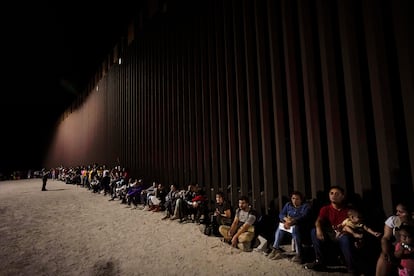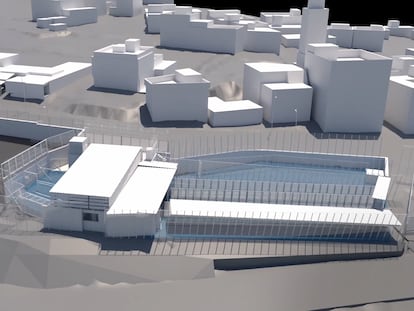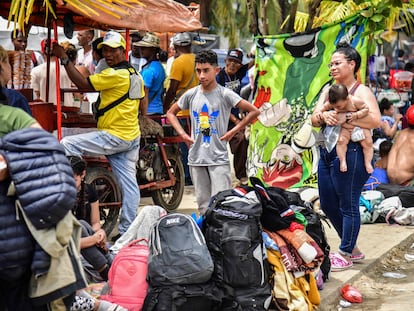Looking for hope underground: The search for the remains of migrants on the US-Mexico border
The Border Project, led by the Argentine Forensic Anthropology Team, has managed to identify the bodies of more than 280 people who died during the perilous crossing

On Friday, March 15, 2011, 20-year-old Baudilio Alexander Castillo left his village in Jumaytepeque, Guatemala, in search of work in Louisiana. Two weeks later, his relatives lost contact with him. After another two weeks passed, his father read in the newspaper that 48 unmarked graves had been found in San Fernando, in the Mexican state of Tamaulipas – the middle of the migration corridor into the United States.
“That’s where our ordeal began,” recounted Baudilio’s father, as he has done so many times, during a forum in Mexico at the end of 2021. “This is my son. He was found in 2011, in grave number one. His corpse was the 14th one they found.” He held up a photograph of his son to punctuate his words.
Since 2014 alone, almost 7,000 migrants have disappeared across the continent – more than 4,000 along the US-Mexico border, according to the United Nations.
It took a long time to confirm that the 14th corpse was Baudilio. In October of 2013, the Argentine Forensic Anthropology Team (EAAF) – a prominent NGO, best-known for identifying 43 Mexican student-teachers who were forcibly disappeared in 2014 – signed an agreement with the Mexican Attorney General’s Office to identify 200 bodies found in pits in northern Mexico, the majority in San Fernando. The delegation of Argentine specialists traveled to Guatemala to take blood samples from the Castillo family, to put together Baudilio’s genetic profile.
There was a legal fight to ensure that the remains exhumed in the state of Tamaulipas would not be cremated, so that DNA could be preserved and subsequently compared to blood samples. The EAAF was ultimately victorious. After years of anguish, Baudilio Alexander Castillo was identified. His remains were repatriated, so that his family could watch over him.
To date, the EAAF’s ‘Border Project’ has managed to identify the bodies of 283 migrants. This project includes tepid support from authorities in the United States, Mexico, Honduras and El Salvador.
“This work shows that, while it is a difficult and painful search situation, it is not impossible to find answers,” says Mercedes Doretti, the EAAF director for Central and North America.
“The project arose in 2009, a bit unexpectedly,” says Doretti, in a telephone interview with EL PAÍS. Argentine forensic specialists had already been working on femicide cases in Ciudad Juárez – one of the epicenters of violence on the northern border of Mexico – for five years.
“We realized that there were many unidentified female remains,” she recalls. “There were 50 remains that did not match any of the families of missing girls reported in the state of Chihuahua.”
The deceased, unidentified women, likely came to work in factories in Juárez, or were trying to cross the border in search of other opportunities. At that point, the specialists were convinced that the element of migration was key to understanding what they were seeing.
Requesting lists of missing women from the Mexican states that see the most migration to Juárez was a simple task. However, in 2009, there was very little genetic information available in Mexico or Central America, making this aspect far more complicated. There were no national DNA banks – the few resources that were available were scattered in isolated offices throughout the region.
“The quantity and quality of the data was very poor… it wasn’t organized. It was very difficult to identify people,” says Doretti.
The project was conceived as a kind of bridge between those who were searching and those who had disappeared. The investigators reached out to families, morgues, municipalities. They scoured mass graves, with the hope of using science as a last resort to find the missing.
One year later, the first forensic database of missing migrants whose bodies had not been located was established.
Part of the job was to approach the families and take various genetic profiles from their blood or saliva, to be able to compare them with the remains found in the field. Interviews were also carried out to obtain information about the missing persons: their name, date of disappearance, country of origin and other relevant data. Finally, the profiles were matched using software. “The relatives welcomed us with open arms,” Doretti sighs.
In addition to the fragmentation of information, one of the main obstacles was the resistance of many authorities. In the countries where remains had been found, several officials refused to share access to their databases. In 2018, the Inter-American Commission on Human Rights asked the US government why it did not allow access to its forensic data for the purpose of cross-checking.
From 2010 until November of 2022, of the missing migrants who have been identified, 123 disappeared in Mexico. 159 disappeared in the US, mostly in Arizona and Texas. Of the individuals found, there were 106 Mexicans, 61 Hondurans, 58 Salvadorans and 45 Guatemalans. The rest were from Nicaragua, Peru, Costa Rica, Brazil and Ecuador.
“We have an identification success rate of between 10 and 15%,” Doretti notes.
The potential for growth is enormous. If the Border Project is able to grow and is given more access to information across the region, many more identifications could be possible. In 2022, the number of family members of the missing who provided blood or saliva samples increased by 43% from the previous year, bolstering the EAAF’s forensic database.
“The main problem is the lack of political will of the countries involved to agree to obtain information and share it,” Doretti explains. “It’s not easy… but 10 years ago, identifying bodies seemed impossible. Today, it’s almost a daily practice.”
In one of the world’s most dangerous migratory corridors, the search for more DNA matches continues. While identifying remains cannot bring a person back, the process can at least offer a small form of solace to the thousands of families in the region who cannot even bury their loved ones.
Sign up for our weekly newsletter to get more English-language news coverage from EL PAÍS USA Edition
Tu suscripción se está usando en otro dispositivo
¿Quieres añadir otro usuario a tu suscripción?
Si continúas leyendo en este dispositivo, no se podrá leer en el otro.
FlechaTu suscripción se está usando en otro dispositivo y solo puedes acceder a EL PAÍS desde un dispositivo a la vez.
Si quieres compartir tu cuenta, cambia tu suscripción a la modalidad Premium, así podrás añadir otro usuario. Cada uno accederá con su propia cuenta de email, lo que os permitirá personalizar vuestra experiencia en EL PAÍS.
¿Tienes una suscripción de empresa? Accede aquí para contratar más cuentas.
En el caso de no saber quién está usando tu cuenta, te recomendamos cambiar tu contraseña aquí.
Si decides continuar compartiendo tu cuenta, este mensaje se mostrará en tu dispositivo y en el de la otra persona que está usando tu cuenta de forma indefinida, afectando a tu experiencia de lectura. Puedes consultar aquí los términos y condiciones de la suscripción digital.
More information
Archived In
Últimas noticias
Rowan Atkinson tops Netflix at 70: ‘He’s as funny as ever’
Israeli recognition of Somaliland stirs up the Gulf
Tiger Woods turns 50: Will he continue playing on the PGA Tour or take a back seat?
The surreal journey of James Nnaji, the Barcelona youth player selected in the NBA Draft who ended up in the NCAA
Most viewed
- Oona Chaplin: ‘I told James Cameron that I was living in a treehouse and starting a permaculture project with a friend’
- Reinhard Genzel, Nobel laureate in physics: ‘One-minute videos will never give you the truth’
- Sinaloa Cartel war is taking its toll on Los Chapitos
- Why the price of coffee has skyrocketed: from Brazilian plantations to specialty coffee houses
- Chevy Chase, the beloved comedian who was a monster off camera: ‘Not everyone hated him, just the people who’ve worked with him’











































